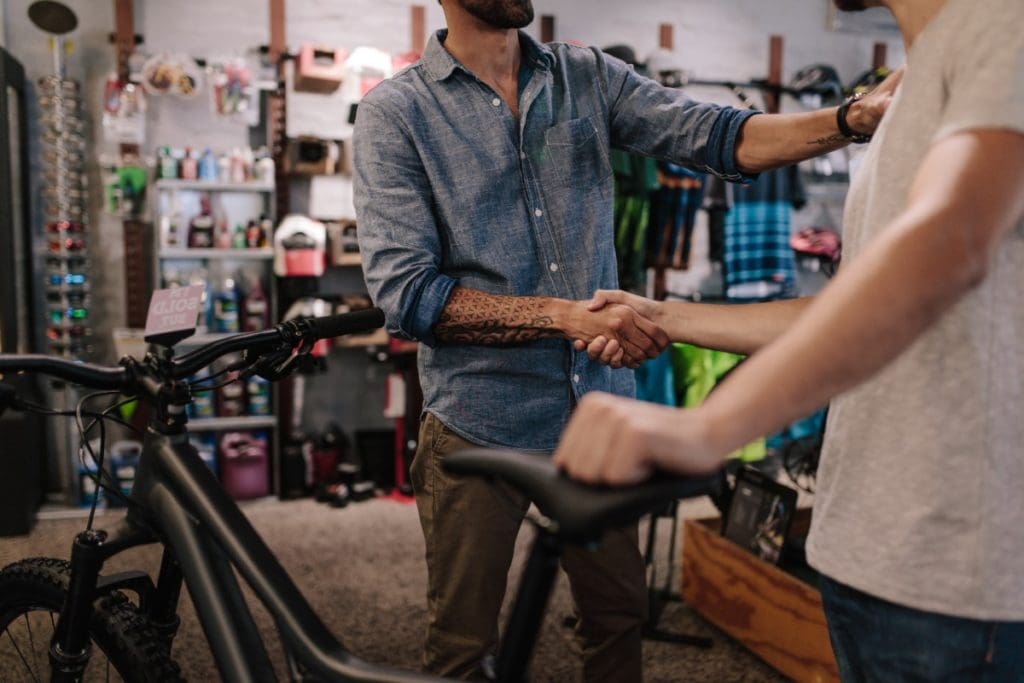What Will Happen to Bicycle Demand in 2021 & 2022?

Just before Christmas I shared with you my opinions about what would happen to bicycle supply over the coming year.
In case you missed the article, which was entitled, ‘If You Read Nothing Else, Read This! My Predictions for 2021 Bike Supply.’, then I suggest you read it first here, before reading this article that follows below.
That article about bike supply was very widely read and I’ve received good feedback from multiple retailers and wholesalers, so I thought I’d follow it up with its logical partner article: my predictions about bicycle demand. I’ll also branch out a little to discuss drivers of demand and which sales channels will do best in fulfilling future demand.
To repeat my caveats from the previous article, my predictions could be wrong, which wouldn’t be the first time, so please feel free to let me know if you think that any part of the following article is off track, either via the comments facility at the end or by contacting me directly.
I’ll divide this article into two sections. In the first, I’ll make some general observations and in the second, I’ll pull these together into more specific predictions across six key areas.
Part One – The Bigger Picture
As everyone knows, the bike boom, ongoing bicycle supply disruption and the level of future demand for bicycles have all been heavily influenced by the Covid-19 pandemic. So before making predictions about future bicycle demand, it’s logical to take stock of where we’re up to with the pandemic and what’s most likely to happen next.
As I write this article it’s the first official day of Covid-19 vaccinations in Australia. We have a better funded, better organised health care system than many other countries, so even though we’ve started vaccinations a month or more later than Europe and North America, I predict that we’ll soon catch up and within a few months we’ll see a significant level of protection leading to further easing of restrictions.
Looking at the global picture, new daily cases have already more than halved from their peak in early January 2021 and daily deaths, as always showing a two to three week lag, have been falling fast since late January.
With the northern hemisphere winter soon coming to an end and vaccines ramping up, we should see these strong declines continue.
Of course, this is provided that enough of the community gets vaccinated. Although ‘anti-vaxxers’ are very vocal, if the small numbers at their recent demonstrations are any gauge, there won’t be enough of them to significantly hamper the ‘heard immunity’ that vaccines will bring – at least in Australia – it may be different in some countries.
It also appears that the relevant scientists are not too worried about the various new strains that we’re seeing, saying that they should be able to modify their vaccines as required, which happens every year with other vaccines such as the annual flu shot.
Taking all of this into account, we should see a world in the second half of 2021 where most adults, in developed countries at least, have been vaccinated and their ‘Immunisation Certificate’ will be like a second passport in terms of required documents for travellers.
Next, travel will cautiously start reopening. There will be a pent-up demand for travel both from business travellers and tourism. There’s even been a new phrase coined to describe this phenomenon, ‘revenge travel’.
This will mean that a huge kink in the travel money hose will be straightened out and the money will start flowing in that direction again.
This will be great for the travel industry, but not entirely great for the bicycle industry, as many customers have been buying new bikes with money that they would normally have spent on travel.
In the 12 months prior to March 2020, when travel restrictions hit home, according to statista.com, Australians spent an estimated $64.94 billion on overseas travel.
We only needed a small fraction of that vast amount of spending to be diverted into cycling to get the bike boom that we all saw.
‘Cycling is a simple solution to many of the world’s most complex problems.’
One final observation that most people would prefer not to talk about. There’s nothing to stop the whole Covid-19 pandemic happening again with a different virus, that could even be more contagious, or more deadly, or harder to find a vaccine for… or all three.
The root causes of Covid-19 are still being investigated by the WHO (World Health Organisation), but it’s widely expected that the WHO’s eventual official report will conclude that it originated in China in Wuhan’s Huanan ‘wet market’.

It’s also possible they’ll conclude that if Chinese authorities had been more transparent and had not supressed ‘whistle blowers’ during the critical earliest phases of the outbreak, then the virus might have been quickly contained and controlled within one small part of China.
You might think, ‘It’s easy to be wise after the event.’ But the same crowded animal meat markets are continuing to operate in crowded, unhygienic conditions, not only in China but in many developing nations.
The same authoritarian regime remains firmly in power in China and ironically, the Chinese economy has fared better than most others in the world since the pandemic began.
This is also the same country that manufactures significantly more of the bicycles and components that we sell in Australia than any other country.
Politicians are keen to call Covid-19 a once in a hundred year pandemic, in part referring to the ‘Spanish Flu’ pandemic of 1918-19 which occurred just over a century ago.
But a virus doesn’t really care what politicians say to downplay its threat, or how loudly they say it, as evidenced by the half million plus deaths in the USA.
So, there’s nothing to stop the next ‘one in a hundred year pandemic’ happening not in 2120, but, say in 2030 or any other year you may care to select.
In fact, the rate of new viruses jumping from animals to humans has not been a historical constant, but is accelerating. These ‘zoonotic’ diseases have included Ebola, HIV, SARS, Zika and more. This is not a random coincidence or bad luck.
Studies have shown that this frequency acceleration relates to a range of factors including increased population pressures, more intensive animal agriculture and increased consumption of wild animals.
On that cheerful note, now let’s move on to some Australian bike industry specifics…
Part Two – Specific Predictions About Future Bicycle Demand for 2021 & 2022
Prediction One: Most bicycle categories will continue upon growth trajectories.
Most categories will continue to grow, but for differing reasons.
For example, ebike growth in general will continue to be driven by rapidly improving technology, growing environmental concerns amongst some consumers and value attracting new consumers.
Demand for mountain bikes, including e-MTB’s will be boosted each time another part of the $100 million dollars of new MTB trails and parks that are still in the pipeline is finally opened.
Gravel bikes also still have upside, driven by popular new gravel bike events and the fact that our bitumen roads are becoming increasingly filled with vehicle traffic. There are a staggering 574,660 kilometres of gravel roads, comprising more than 60% of Australia’s total road length. Most of these gravel roads carry very few vehicles per hour, or even per day, making cycling much safer and more fun.
I think road bikes might grow more slowly than these other categories, although if the rumours are correct, then we’ll be seeing major new upgrades from Shimano to 12 speed wireless, for both their Dura-Ace and Ultegra group sets. Usually, major upgrades drive demand from high end buyers. Although the volumes are small, the unit values are sky high, so the total dollars are significant – provided dealers can access enough bikes to sell.
Prediction Two: Events will quickly ramp up again, boosting bike demand.
Everything from triathlons to charity rides, road and MTB races and the iconic one day mass participation events should be back on track soon. If the covid vaccines do their job, then there’s no reason that participant numbers won’t bounce straight back to pre-pandemic levels, or perhaps even to higher levels initially due to pent up demand.
Hopefully, we’ll also see expos and other trade events also coming back online, including the return of the Tour Down Under and the deferred debut of Sea Otter Australia, now scheduled for the long weekend of October 2021.
Longer term, the UCI Road World Championships are coming to Wollongong NSW 18th-25th September 2022.
All of these events, to a greater or lesser extent, help to drive demand, not just for bicycle sales, but P&A and repairs.
Prediction Three: IBD’s will face increasing competition, some of it from new sectors.
Notwithstanding ongoing supply issues, most of Australia’s independent bicycle dealers have just had a record year.
But just as the splashing swimmer attracts the shark, new entrants backed by new investors have been eyeing the growth in our sector and are circling more closely.
So far most of them are still focused on the bigger markets of Europe and North America. But as ‘normality’ returns, travel reopens and supply catches up with demand, don’t be surprised if we see well-funded new names entering our retail market before the end of 2022.
Some direct-to-consumer names to look out for include Rad Power and VanMoof. These relatively new direct brands and others are attracting unprecedented levels of venture capital funding, allowing them to aggressively expand.
Then there’s retail chains such as Pure Electric in the UK, which has grown from one to 17 stores across the UK in the blink of an eye, whilst also opening in Belgium, France and Spain.
Next, there are the ‘Big Box’ retailers already in Australia but ready to resume their growth plans. In particular Decathlon, which so far only has two stores in each of Sydney and Melbourne, plans many more. Decathlon is the world’s biggest retailer of bicycles, with estimated sales of over three million units per year across their 1,500 store, 55 country empire. Their buying power is second to none.

Then there’s competition from within our shores.
99 Bikes, already by far Australia’s largest specialist bicycle retail chain, has 52 Australian stores at last count, plus more in New Zealand.
They’ve taken advantage of the travel downturn during covid to recruit some very talented head office staff who would otherwise have been retrenched from their sister company, Flight Centre. They’ve also started importing and selling a broader range of international bike brands to keep supply flowing and look set to continue to grow their market share.
Finally, another emerging competitor sector doesn’t even sell bikes at all… they lease or rent them. New companies doing this in Australia such as Lug and Carrie, are quite small. But there are international examples such as Swapfiets which has huge funding, at least 1,300 staff and has openly said that they’re considering expansion into Australia.
Prediction Four: Electric scooter demand will surge.
Most bike shops currently don’t want to touch electric scooters, with valid reasons. This month’s ‘How’s Business?’ gives a snapshot of dealer sentiments about e-scooters.
They’re not yet legal in most jurisdictions and some brands do not back up their e-scooters with spare parts and warranties to the high level that dealers are used to from the major bicycle brands.
But these factors have not stopped mass merchants and other outlets selling e-scooters by the container load.
Scooters will get stronger and safer. New three wheeled adult scooter models will make them less intimidating to people who haven’t learned to ride one as a kid. Then there will be scooters with seats, which is a whole new category.
There is already movement within government bureaucracy towards legalising e-scooters and in each state where this happens, sales will surge. It will then be up to dealers to decide if they want be part of this huge market or not.
Prediction Five: Family and kids bike markets will be steady but unspectacular.
In ‘peak lockdown’, wonderful sights of bike paths full of families experiencing the joy of cycling together, perhaps for the first time, were being reported by dealers across Australia.
Unfortunately, I don’t think we’ll be seeing that level of activity again any time soon.
But it seems that the BMX market has made a comeback that looks like continuing. And in general, the family market should remain solid.
This sector is the canary in the coal mine when it comes to safe facilities to ride, which leads to my final prediction.
Prediction Six: The Elephant in the room will continue to be the user-friendliness of our cycling environment.
There are multiple reasons we saw a surge in both consumer demand and in cycling activity during covid. Clearly a lack of alternative things to do and a consequent sudden reduction in alternative spending, on everything from travel to sporting and concert tickets, were two big factors.
But the lack of vehicle traffic on our roads was also a huge factor. When there was hardly a car in sight, roads that you’d normally not dare ride on yourself were now fair game for a whole family adventure.
Now that we’re back to 100% pre-covid traffic levels – or even more in some cases due to lower public transport use and resurgent new car sales and booming used car sales – those traffic-lite days are long gone.
If you look at the big growth sectors over recent years: mountain bikes, e-mountain bikes, gravel bikes and scooters, they’re all devices that let the rider get away from the traffic, whether it be onto MTB trails, back roads or footpaths in the case of scooters.
But what about all the rest? Road bikes, family bikes, commuter bikes and so on? Every day use and therefore bicycle sales in these categories, won’t dramatically grow unless space is made, where we live, for everyday bikes.
So, we’re back to our decades long grinding battles for more and better protected lanes, lower speed limits and more tolerant attitudes from our media and broader community.
Those fighting these battles on our behalf at local, state and federal levels all deserve medals for their persistence and selfless work, mostly unpaid and under-recognised.
Even though these people will receive no financial dividend, I believe that their level of success will be a key factor in how strongly demand for bicycles grows over coming years.
Here Comes the Cavalry!
Finally, on a positive note, the cavalry is coming from an unexpected direction… and riding weird looking horses!
I’m referring to the scooter and bike share sector.
They’ll be a fast-growing, well-funded, new ally campaigning for all of these things that will grow demand for bike purchases. Some of these companies have market capitalisations of well over a billion dollars. They have the cash to hire smart people and lobby hard.
Far from reducing sales, overseas experience suggests that share scheme users often go on to buy bikes and scooters for themselves.
Conclusion
As a leading cycling advocate once said many years ago, ‘Cycling is a simple solution to many of the world’s most complex problems.’
Since then, those problems, such as climate change, poor mental and physical health, traffic congestion in our cities, air and noise pollution and others have been getting worse, not better.
Cycling remains a simple, low cost, low impact solution. One by one, other cities and countries around the world have been starting to take notice of the solution that our industry provides and getting serious about taking action.
If we all do our best, in whatever our role and market, together we can help drag the hour hand forward so that Australia’s day finally comes.
Join the conversation: We love healthy and robust discussion at The Latz Report. What do you think of the predictions and do you have any to add of your own? Please comment below.

Thanks Phi – useful and interesting.
Well done Phil great article. This is my biggest year in helmets for 10 years .
That’s great news Bob. I’ve been hearing that some helmets styles / brands have been in short supply since Covid began.
The biggest sleeping giant is the retrofit market.